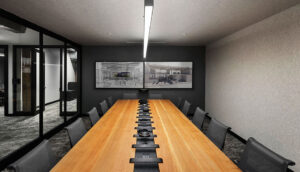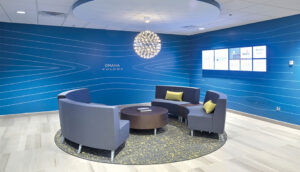Changing spaces
2/3/2021 Changing trends have regularly caused business leaders to rethink their use of office space. From a time when clunky rotary phones were placed on heavy wooden desks, to the days of cubicle central surrounded by offices with windows, to the open space layout devoted to collaboration, ideas about what makes an office space productive have evolved and adapted.
Changing trends have regularly caused business leaders to rethink their use of office space. From a time when clunky rotary phones were placed on heavy wooden desks, to the days of cubicle central surrounded by offices with windows, to the open space layout devoted to collaboration, ideas about what makes an office space productive have evolved and adapted.
Enter the year 2020 and a pandemic. Local business leaders scrambled to situate employees to work remotely, and, as the months passed, they began to revision the future of their workforce and their office spaces.
Space to spare

Korey Birkenholtz, vice
president CBRE|Hubbell
Commercial
With fewer — and sometimes no — employees working from the office for what has turned into a period of months, local business owners and managers began to look at the bottom line and wonder if they needed as much space as they had. Many have decided they don’t, and the result is that they have condensed operations into less space and have looked at subleasing the remaining space.
The CBRE|Hubbell Commercial Marketview Snapshot for the fourth quarter 2020 tells the story: More commercial real estate space is now available for subleasing. More commercial space is on the market largely due to the “surges in new supply from user-driven reductions of existing office occupancy just prior to the pandemic,” according to the report.
The situation only became more pronounced when the pandemic hit, bringing “historically low demand in 2020 as new leasing activity fell
approximately 38 percent year-over-year.”
It may be bad news for commercial real estate companies, but it has been good news for tenants who are finding the average lease rate has fallen.
This trend is likely to continue well into 2021, says Korey Birkenholtz, vice president CBRE|Hubbell Commercial. “I find it interesting that the sublease space is 6 percent. I think it will increase. Historically, it is typical for 1-3 percent of available space to be sublease space. More businesses are trying to sublease in order to recoup some money.”
A new attitude

Collin Barnes, senior
partner, corporate focus
market leader, RDG
Planning & Design
With business owners finding financial benefits to using less office space, some are questioning the need to return workers to the office at pre-pandemic levels. The Harvard Business Review found that employers now have more confidence that employees can be productive working from home.
Employers and employees have discovered that the importance of office space isn’t simply to provide work space but to provide opportunities to build corporate culture and to collaborate.
“In the Midwest, we are seeing a bit of a pause,” says Collin Barnes, senior partner, corporate focus market leader, RDG Planning & Design. Employers have found that remote work can be effective and are now “analyzing the processes. What is really necessary when it comes to the office? What activities can’t be replaced?” she says.
The office is vital to the corporate culture, camaraderie and on-boarding of new staff, says Barnes.
“Those group-based tasks are more of a struggle when not in the office,” she says.
With many staff members working remotely, “big corporations are finding it extremely hard to attract talent,” says Birkenholtz. “Recruiting these folks and telling them what the company is like” is not as effective as having them come into the office and meet people. “They can’t see what the corporate identity is or make friends,” he says.
As business leaders re-think use of space, they are focusing more on what activities are important in the office, such as the need for space to collaborate, quiet space for phone calls and individual tasks, and places to “touchdown” (to use briefly to do the basics such as check email and messages), reports the Commercial Investment Real Estate Institute. The change in emphasis would give workers the opportunity to work in different areas depending on the needs of the tasks at hand.

Claire Brehmer, senior communications specialist Hubbell Realty Co.
More business are adding conference rooms of different configurations and phone rooms, says Barnes.
“Remote work is not going away,” so Barnes says she expects businesses will decrease the amount of individual work space and renovate existing space for training rooms, multipurpose rooms and conference areas, as well as phone rooms that may be available as needed.
Employees, too, are expressing a desire to have the flexibility to work at home or in the office.
“Most conversations I have with larger employers is that working virtually can work, but they are hearing more and more people want their space in the office and miss those ‘collision’ opportunities with co-workers,” says Birkenholtz. “They want to get out of the house and out of their pajamas.”
While technology has allowed co-workers to communicate in a variety of ways remotely, it has created some “gaps” in communication, says
Birkenholtz. Now, instead of walking down the hall to talk to a co-worker, he says he has to schedule a meeting, and working around schedules can cause its own problems.
He anticipates that many employers will end up with a hybrid model with employees working in the office for the most part but also at home
some days.
“The amount of space they will need in the office remains to be seen,” he says.
At Hubbell Realty, many employees are being brought back into the office “at their discretion,” says Claire Brehmer, senior communications specialist Hubbell Realty Co. Many people want to come back to the office, she says. Although a variety of methods were used to communicate with each other and to stay connected in fun ways as well, co-workers still miss each other, she adds.
“It feels like there is a light at the end of the tunnel,” says Birkenholtz.
Getting creative
Owners of commercial real estate are getting creative in their use of the extra space they may have, using those spaces as “community spaces” or as conference centers. Doing so can help attract tenants when there is more supply than demand, says Birkenholtz.
“If they offer amenities to existing tenants, it brings a cool feeling to the office building — it’s like the living room of the building,” says Birkenholtz. He points to Capitol Square as one office building that has incorporated many uses other than office space, with its atrium available for larger functions and events and other types of business such as restaurants and retail spaces on the lower floors.
Individual offices are adding unique spaces such as coffee bars, resource rooms, fitness centers and more to attract and keep employees.
More are also focusing on the wellbeing aspects of work areas, according to digiday.com. This includes an emphasis on natural light and plants, providing outdoor areas for breaks, and allowing for more movement by employees during the work day.
clutch.co concurs that employees are looking for wellbeing features, as well as more flexibility in their work day and amenities such as plenty of bathrooms, comfort in furniture and an office area that is aesthetically pleasing.
Design and technology

Conference rooms are becoming increasingly high tech, with built-in technology, including in the furniture, and lighting that is optimal for virtual meetings. Architecture by RDG Planning and Design. Photo by Jacob Sharp Photo
With technology central to many office jobs, office design increasingly needs to take into account the technology used there, says Brehmer.
“Technology needs are more pressing,” agrees Birkenholtz. “It’s becoming essential to integrate it into buildings, such as in conference rooms.”
With availability of Wi-Fi, employers can provide more flexibility to employees, who can work in multiple locations instead of being tied to a desk. Incorporating technology into a building can allow for a variety of options and for spaces to be adapted according to changing needs, according to the Commercial Investment Real Estate Institute. Smart technology, movable walls, outlets in the floor instead of just the walls all can allow for changing configurations and creative solutions.
The use of virtual meetings “impacts on how we light spaces and the acoustics,” says Barnes. “The phone in the middle of the conference table” is a thing of the past. Now, office spaces are being designed with permanent technology components.
“The proper lighting needs to be built in and furniture will have microphones and speakers built in,” says Barnes.

More offices are incorporating areas for small groups to meet and for working in a relaxed — and aesthetically pleasing — setting. Architecture by RDG Planning and Design. Photo by Kessler Photography
Space can be used more efficiently if it can be reconfigured to serve multiple uses, and technology such as Wi-Fi allows for this, according to digiday.com. Smart technology can even monitor how the space is used and provide management with data on whether the space is used effectively.
Although the focus may be on group space, “it doesn’t negate the need for quiet, head-down areas,” says Barnes. “I’m not convinced we’ll need one for each person. They may be assigned or shared,” she says.
Ultimately, office design will be “much more personalized,” says Barnes. “People who want to work at the coffeeshop can, and space will need to be provided for those who need it.” Addressing the needs of each individual business depends on “getting to know the organization,” she says.
“No two space designs are the same,” Barnes says. “We have to get to know the organization. What’s their mission? How do they work? And what is good for the person?” ♦




















